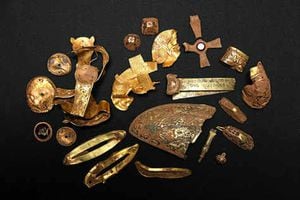Saxon hoard: A golden discovery - TV review
As a pupil of Newport Junior School in the 1970s, I remember fondly working on historical projects, particularly in the final year.

As a pupil of Newport Junior School in the 1970s, I remember fondly working on historical projects, particularly in the final year.
Learning all about the Victorians was fascinating, as was the study of inventors and their inventions. But one period of time I really enjoyed learning about was the Saxons.
Little was known of the era in reality, fleshed out by much speculation, based on sporadic archaeological finds and texts. But new light was thrown on the Dark Ages just a few years ago.
Back in the summer of 2009, a reluctant farmer finally relented to the requests of a group of metal-detecting enthusiasts, allowing them onto his land near Hammerwich. At the time, likeable curmudgeon Fred Johnson had no idea how significant this decision would be, nor what it would yield.
In last night's documentary, historian Dan Snow tried to shed further light on the importance of the find in Staffordshire – a find that would raise as many questions as it answered.
The Staffordshire Hoard, as it was labelled, dates back to the 7th century – the Dark Ages – supposedly a time of mud huts and crude pots.
So, when Terry Herbert took to farmer Fred's land, he was truly shocked by what he found. Experts were amazed when they arrived, and a few weeks later Terry became a benefactor when the find was named as treasure trove, netting more than £1.6 million. And it wasn't only Terry that benefited. Fred got his share . . . and Argos did pretty well too, as sales of metal detectors soared.
As these new treasure hunters dug up cola cans and 10p pieces, the hoard, like some reformed rock band, went on tour, generating queues rarely seen at museums.
While a few would come out of the find financially better off, the rest of us would be all the richer for knowing a little more about our ancestors.
The kingdom of Mercia, the Midlands of its day, has always been thought of as a most significant area at the time. The hoard seems to reinforce this theory, making Tamworth – the heart of Mercian power – even more important. Armies from Wales came to Mercia and it is believed that the hoard may have been taken from Tamworth and buried in the land that now belongs to Mr Johnson.
The hoard includes weaponry – lots of weaponry. Well, weapon attachments. It is possible that this group of objects formed a collection of gifts to a king of the time. These weapon attachments were the 'bling' of their day, attached to whatever blade the warrior was using - like a private number plate that would be moved from car to car in 21st century Britain.
The A5 as we know it today was a major route from London – known as Watling Street – and the hoard was discovered close to this ancient route.
Experts believe it is most likely to be treasure recovered from a battlefield, twisted and mangled during the skirmish.
The intricate designs, often in jewelled gold, would be stunning if produced today, never mind in the 600s. And King Pende, last of the great Pagan kings, ruler of Mercia, is believed to be linked to the hoard. On his death in 655ad, Mercia finally converted to Christianity, a major change pointing to how we live today.
So, rather than the simple folk from my school text books, Anglo Saxons actually appear to have been powerful, wealthy and sophisticated, where kingdoms battled kingdoms for supremacy and religions conflicted, resulting in the last days of the pagans.
As Dan Snow says, studying the Staffordshire Hoard over the coming years may reveal much more about our past, changing our origins forever.
Paul Naylor





